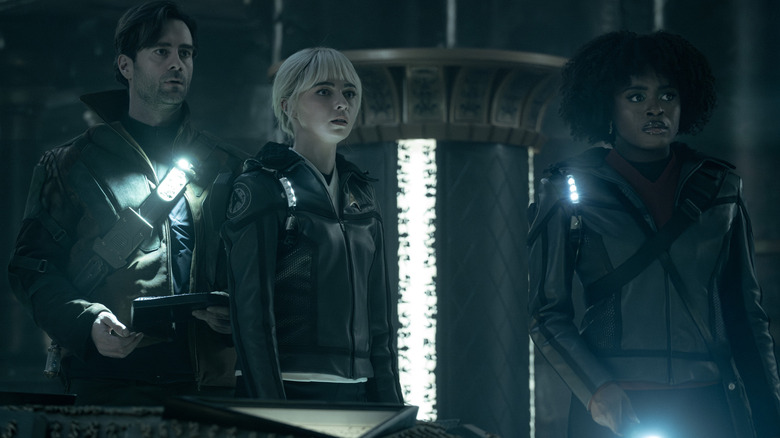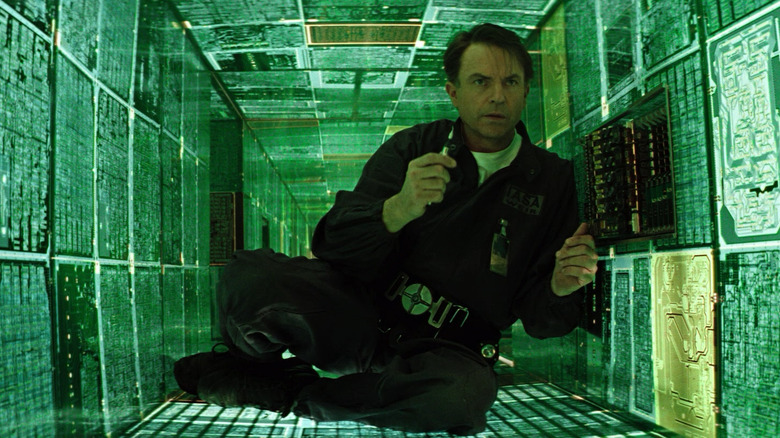
Set phasers to spoilers. This article discusses major events from the latest episode of "Star Trek: Strange New Worlds."
If the creative team behind "Strange New Worlds" are trying to convince us that "Star Trek" can support any possible combination of genres and tones, season 3 is already proving to be a brilliant case study. In the span of only five episodes, we've seen an action thriller with the Gorn, a romantic fantasy drama (emphasis on fantasy) featuring Spock (Ethan Peck) and Nurse Chapel
(Jess Bush), a self-contained zombie invasion, and a whimsical throwback to the aesthetics of "The Original Series" wrapped in a murder-mystery plot. Now, the show's writers have just unleashed what might go down as the most ambitious hour yet in all of "Strange New Worlds," and it takes a page (or two) out of a pair of under-appreciated horror touchstones.
Yes, "Star Trek" is once again voyaging into the cosmic unknown with season 3, episode 5, fittingly titled "Through the Lens of Time." This time, however, it's drawn inspiration from some unusual sources. When the story begins, it seems we might be in for an "Indiana Jones" riff as Chapel and Dr. Roger Korby (Cillian O'Sullivan) lead an excavation of an ancient archaeological site. But what starts with a sense of wonder and exploration soon devolves into the most Lovecraftian of horrors. The away team quickly discovers that the "treasures" waiting for them inside the hidden structure are anything but: automated (and quite deadly) self-defense mechanisms, time/space paradoxes, and inter-dimensional aliens just itching for their chance to escape.
As our characters go deeper and deeper into this house of horrors, two movies in particular feel like spiritual siblings to what "Strange New Worlds" attempts here: Paul W.S. Anderson's 1997 cult classic "Event Horizon" and Ridley Scott's 2012 "Alien" prequel "Prometheus." Add that to the usual franchise hallmarks of using science to explain the unknown, and the final result is as unique as anything we've seen in "Star Trek" before. The series has given us a taste of the existential, and there's no going back now.
Read more: The 15 Best Guest Stars On Star Trek, Ranked
Strange New Worlds Takes A Page Out Of The Prometheus Playbook

You know, maybe there are worse things in life than death. Humanity has always been obsessed with immortality and the idea of what comes next after we pass away, but nothing good ever comes from probing too deeply into those questions. Countless stories and cautionary tales warn us about the costs of meddling with things we have no control of, with "Prometheus" standing out as one of the more intriguing examples that science fiction cinema has had to offer over the last few decades. When you filter such high-minded concerns through the usually idealistic lens of "Star Trek," you'd think that horror would be the last thing on its mind. Instead, "Strange New Worlds" just jumped feet-first into the mouth of mayhem.
It all begins to go wrong when the crew of the USS Enterprise come across an archaeological wonder on an alien world, which might contain answers to the mysteries behind solving immortality. Unfortunately, red flags begin popping up when the team encounters dead bodies, a glowing orb that explodes violently in the face of poor Ensign Gamble (Chris Myers), and a defense mechanism that kills their local guide Njal (Ish Morris), trapping them inside the structure. Their only way out is to go further in, naturally, but not a single one of these hardened Starfleet officers could've ever anticipated what they'd come across next.
The superficial "Prometheus" parallels are rather hard to miss, but what truly links the two together comes from the thematic idea of cheating death and searching for clues to our own origins. The indigenous extraterrestrial NJal seeks these answers for his people, which is why he recruits the help of Starfleet in the first place. But this search is also what leads directly to his own death, when he comes face to face with an "evil" only referred to as the Vezda. Whatever he glimpses in the next chamber scares him enough to flee the area completely, though this ends in tragedy when he's instantly vaporized by the defenses in the door and the rest of the survivors are left to an uncertain fate inside. Like the crew of the Prometheus, their quest for answers brings them far more than what they bargained for. Rather than meeting their makers, however, our "Strange New Worlds" characters instead find the villains that were left behind.
Like Event Horizon, Strange New Worlds Encounters A Gateway To Other Dimensions

And this is where things take a hellish turn into "Event Horizon" territory, as we eventually learn that what the Enterprise crew thought was a temple or research facility was actually an interdimensional prison. When Ensign Gamble comes uncomfortably close to one of these Vezda and gruesomely loses his eyesight, well, it's probably not a coincidence that these visuals so strongly match what happens to Sam Neill's Dr. Weir and the rest of the unfortunate victims of the starship named Event Horizon. Let's just say the similarities don't end with bleeding eyes, however. The overmatched protagonists of "Event Horizon," tasked with investigating the long-lost ship that disappeared without a trace several years before, come to realize that it didn't come back alone. Having traveled beyond the limits of our own universe (and possibly even Hell itself), the ship brings back something that caused its original crew to turn on each other ... before doing the same to Dr. Weir, who designed the ship and its faster-than-light "gateway" drive, along with the rest of the rescue team.
Gamble ends up in a similarly sticky situation, possessed by one of the Vezda and compelled to turn on his fellow Starfleet officers in order to escape imprisonment. Like the antagonist of "Event Horizon," this inter-dimensional entity defies human understanding and hints at a horrifying region of the universe beyond our own reach. According to Pelia (Carol Kane), the Vezda are pure evil incarnate. Watching what Anderson does with "Event Horizon," well, it's hardly a stretch to ascribe the exact same malevolence to whatever ends up haunting that ship. Between the allusions to Hell, the nightmarish imagery of what happened with the initial crew, and the general Lovecraftian tone and visuals, the film can easily be classified as supernatural horror. "Strange New Worlds" at least dabbles in the same unsettling territory, though it ultimately leaves this unresolved with one final tease. Once Pelia shoots and kills "Gamble," the recaptured Vezda is transported into the ship's pattern buffer and effectively imprisoned ... though a glitching console suggests we haven't seen the last of it -- or the show's fascination with sci-fi horror classics -- just yet.
New episodes of "Star Trek: Strange New Worlds" premiere Thursdays on Paramount+.
If you're looking for the easiest way to keep up with all the major movie and TV news, why not sign up to our free newsletter?
Read the original article on SlashFilm.











